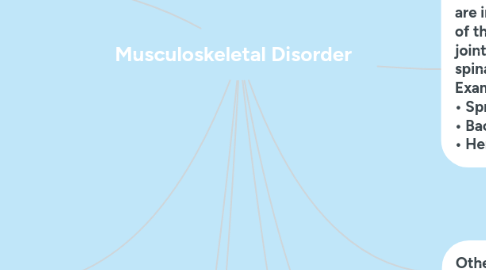
1. Causes of MSD's
1.1. - Sudden overload - Sustained or repetitive or loading - Prolonged overuse with insufficient time for repair of muscle
1.2. “Epidemiological studies have shown that some personal risk factors for MSDs such as smoking, being overweight, or in poor physical shape are the same factors as those relating to poor general health. Therefore, general health promotion at the workplace might be one option to prevent MSDs.”
2. Carpal tunnel syndrome
2.1. A common condition that causes pain, numbness, and tingling in the hand and arm. The condition occurs when the median nerve to the hand is squeezed or compressed as it travels through the wrist
2.2. Risk factors
2.2.1. Heredity Repetitive hand use Hand and wrist position Pregnancy Health conditions such as Diabetes, rheumatoid arthritis, and thyroid gland imbalance
2.3. Symptoms
2.3.1. Numbness, tingling, burning, and pain Occasional shock-like sensations that radiate to the thumb and index, middle, and ring fingers Pain or tingling Weakness
3. Tennis elbow or lateral epicondylitis
3.1. Signs and symptoms of tennis elbow
3.1.1. Pain or burning on the outer part of your elbow, Weak grip strength Sometimes pain at night
3.2. Inflammation of the tendons that join the forearm muscles on the lateral side of the elbow and leading to pain and tenderness from the overuse and repetition of the same motions by the forearm muscles and tendons.
4. Shoulder Impingement/Rotator Cuff Tendinitis
4.1. The rotator cuff muscles is a common source of pain in the shoulder resulting:
4.1.1. Tendinitis: The rotator cuff tendons can be irritated or damaged.
4.1.2. Bursitis: The bursa may become inflamed and swell with more fluid
4.1.3. Impingement: When raising arm to shoulder height, the space between the acromion and rotator cuff narrows. The acromion can rub against the tendon and the bursa, causing irritation and pain.
5. Musculoskeletal disorders (MSD) are injuries or disorders of the muscles, nerves, tendons, joints, cartilage, and spinal discs. Examples of MSDs include: • Sprains, strains, and tears • Back pain • Hernia
6. Other common musculoskeletal disorders include:
6.1. Carpal Tunnel Syndrome. Tendonitis. Muscle / Tendon strain. Ligament Sprain. Tension Neck Syndrome. Thoracic Outlet Compression. Rotator Cuff Tendonitis. Epicondylitis.
7. Goniometer The art and science of measuring the joint ranges in each plane of the joint are called goniometry
7.1. The goniometer is used in the following:
7.1.1. Presence of dysfunction related to muscles, tendons, or joints. Developing goals of treatment Evaluating progress or regress Modification of treatment based on the progress Measurement for empirical purpose
8. Medial Epicondylitis / Golfer's elbow
8.1. Overuse syndrome caused by eccentric overload of the flexor-pronator mass at the medial epicondyle.
8.2. Symptoms
8.2.1. - Sudden onset pain over medial epicondyle - Aggravates with wrist and forearm motion worse with gripping - During early acceleration
